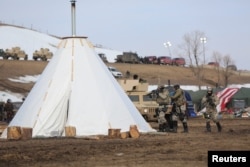A nearly year-long standoff at Standing Rock between Native American “water protectors” and U.S. military engineers has ended, after state and local police evicted the last of the protesters.
Police teams began to move into the Oceti Sakowin camp near Cannonball, N.D. around mid-morning Thursday, working to clear buildings of the several dozen protesters who remained. Shortly after two p.m. and some four dozen arrests later, they declared their job was done.
“Symbolically the closing of the camp was a tough day for the water protectors, the tribes and those across the world standing in solidarity with Standing Rock,” said Phillip Ellis, a spokesman for Earthjustice, the nonprofit environmental law organization representing the Standing Rock Tribe in its challenges against the pipeline.
The Dakota Access Pipeline, owned by Texas-based Energy Transfer Partners (ETP), was designed to transport a half a million barrels of crude oil a day more than 1,600 kilometers from the Bakken oilfields in northwest North Dakota to refineries and other pipelines in Illinois. By mid-2016, the pipeline was all-but-completed, save for a segment planned to run under Lake Oahe, a reservoir formed by a dam on the Missouri River in land seized from the Standing Rock Sioux tribe.
During the final weeks of Barack Obama’s presidency, the Army Corps of Engineers delayed a decision that would have allowed ETP to begin underwater drilling, and called for additional environmental impact studies.
But in January, President Donald Trump issued a directive calling on the Department of the Army and the Army Corps to take all “necessary and appropriate steps” necessary to permit construction and operation of the pipeline, citing the “national interest.” He noted that the DAPL and XL Keystone pipeline together would create thousands of new jobs for Americans.
Ellis maintains that Trump and the Army Corps of Engineers have acted in violation of the law and an 1868 treaty with the Sioux.
In January, the Administration said it would work closely with all parties involved as the pipeline project developed. In his regular press briefing Thursday, White House press secretary Sean Spicer said, “our team has been in contact with all the parties involved.”
However, Standing Rock Tribal Chairman David Archambault II released a statement shortly afterwards, saying, “That claim is absolutely false…We repeatedly asked for meetings with the Trump Administration, but never received one until the day they notified Congress that they were issuing the easement.”
Pipeline safety
The oil industry has long contended that transporting oil through pipelines is far safer than by truck or train. But studies have shown this may not be the case:
The U.S. Environmental Protection Agency requires all oil spills and other industrial accidents to be reported to the U.S. Coast Guard’s National Response Center, information which the Center makes available on its public website.
The environmental non-profit Louisiana Bucket Brigade (LBB) recently examined the accident history of ETP and its Sunoco subsidiary. Their findings show that ETP/Sunoco was cited in 69 accidents during 2015 and 2016. The majority of them – 51 percent – involved pipelines. The spills ranged in type and magnitude; in all, more than 111,000 gallons of pollution ended up being released into the environment and tens of thousands of gallons flowed into ponds, streams and rivers.
“What our report focused on is the fact that Energy Transfer Partners, whether in pipelines, refineries on shore or other infrastructures, has a history of polluting drinking water sources,” said Anne Rolfes, LBB’s founding director. “And our feeling in looking at this information is that the Standing Rock Sioux are absolutely right in being concerned about their drinking watyer because this company has a past.”
ETP did not respond to VOA’s request for comment.
Looking forward
The protests may have ended, but the fight against the pipeline will continue, say organizers.
On February 14, the tribe filed a motion in federal court, asking a judge to set aside Trump’s pipeline reversal to be set aside.
“We’ve asked for an expedited schedule so we can get a ruling on this case before oil starts flowing through the pipeline,” said Ellis. “The judge initially gave a 3 week schedule to rule on this motion. He has yet to set a court date, but we expect it could happen by the first week of March.”
In the meantime, organizers and supporters plan a march on the White House March 10th, said Ellis, “to peacefully - but powerfully - show solidarity with indigenous people around the world.”












